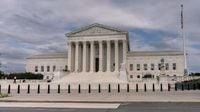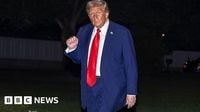The U.S. Supreme Court has ignited a fierce debate over the future of independent federal agencies, after ruling on September 22, 2025, that President Donald Trump could immediately dismiss Federal Trade Commission (FTC) Commissioner Rebecca Slaughter, the last remaining Democrat on the five-member panel. The decision, delivered in a 6-3 split along ideological lines, marks a dramatic turning point in the nearly century-old legal framework that has shielded independent agencies from direct presidential control.
At the heart of the dispute is a 1935 Supreme Court decision known as Humphrey’s Executor v. United States, which upheld Congress’s authority to create agencies like the FTC with bipartisan membership and protections against removal except for cause, such as misconduct or neglect of duty. For decades, this precedent has served as a bulwark against partisan influence, ensuring that regulatory bodies could operate with a measure of autonomy from the Oval Office. But as of this week, the Supreme Court has signaled its willingness to reconsider—and potentially dismantle—that arrangement.
The case began earlier this year, when President Trump fired both Democratic commissioners from the FTC, Rebecca Slaughter and Alvaro Bedoya, in March 2025. Bedoya ultimately resigned, but Slaughter mounted a legal challenge, arguing that her removal violated the longstanding precedent. A federal judge sided with her in July, declaring the dismissal “unlawful” under Humphrey’s Executor, and the U.S. Court of Appeals for the District of Columbia Circuit reached a similar conclusion. Nonetheless, the Supreme Court intervened with a temporary stay earlier this month, allowing Trump’s action to stand while the justices considered whether to take up the broader constitutional question.
On Monday, the court made its intentions clear. Not only did it uphold Trump’s firing of Slaughter, but it also agreed to hear arguments in December on whether to overturn the 1935 precedent outright. According to BBC, the ruling “lets Trump fire Slaughter while legal challenges continue,” and the court’s majority “sided with Trump, allowing him to fire Democratic Commissioner Rebecca Slaughter from her post while legal challenges continue.” The decision has immediate consequences: Slaughter’s name has already been removed from the FTC’s website, and the agency is left entirely under the president’s control for the first time in modern history.
The ramifications could be seismic. As NPR notes, “if the handwriting on the wall is as clear as it seems to be, the independent agencies won’t be independent. Their membership will be subject to the will of the president.” The court’s conservatives appear poised to embrace the so-called “unitary executive” theory, which holds that the president has unfettered authority over the executive branch, including the power to hire and fire agency officials at will. This approach would upend the bipartisan structure Congress designed for agencies like the FTC, the Securities and Exchange Commission, and potentially even the Federal Reserve.
Supporters of the court’s intervention argue that the Constitution vests the president with broad executive authority. Attorney General Pam Bondi, welcoming the court’s move, declared on X (formerly Twitter) that “the president, not a lower court judge, has hiring and firing power over executive officials.” This view is echoed by those who see the proliferation of independent agencies as an affront to democratic accountability, arguing that presidents should have the power to remove officials who do not align with their policy goals or who, in their view, obstruct the will of the electorate.
Yet critics warn the ruling could erode the very checks and balances that have defined American governance for generations. Justice Elena Kagan, writing in dissent for the court’s three liberal justices, sounded the alarm in unusually forceful terms. “The President cannot, as he concededly did here, fire an FTC Commissioner without any reason,” Kagan wrote, as quoted by Democracy Docket. “To reach a different result requires reversing the rule stated in Humphrey’s: It entails overriding rather than accepting Congress’s judgment about agency design.” She continued, “The majority may be raring to take that action, as its grant of certiorari before judgment suggests. But until the deed is done, Humphrey controls, and prevents the majority from giving the President the unlimited removal power Congress denied him.”
Justice Kagan’s dissent also took aim at the court’s increasing reliance on the so-called “shadow docket”—emergency orders issued without full briefing or oral argument. She lamented, “Our emergency docket should never be used, as it has been this year, to permit what our own precedent bars. Still more, it should not be used, as it also has been, to transfer government authority from Congress to the President, and thus to reshape the Nation’s separation of powers.” This critique has resonated with lower court judges and legal scholars, who worry that such orders muddy the legal waters and undermine the predictability of the law.
Slaughter’s lawyers, for their part, emphasized the broader implications for the American public. “Congress gave independent regulators removal protections to preserve the integrity of our economy,” they said in a statement reported by The New York Times. “Giving the executive branch unchecked power over who sits on these boards and commissions would have seismic implications for our economy that will harm ordinary Americans.”
The stakes extend beyond the FTC. The Supreme Court is also considering whether President Trump can remove Lisa Cook as a Federal Reserve governor, after Cook was fired in August 2025 amid allegations of mortgage fraud—a charge she has denied, and for which a federal court ruled the president lacked removal authority. The outcome of these cases could reshape the landscape for dozens of agencies, affecting everything from financial regulation to consumer protection and environmental oversight.
Trump’s approach to executive power has been nothing if not aggressive. According to NPR and BBC, he has sought to “reshape the federal government using aggressive executive power, including firing thousands of federal workers and attempting to control the Federal Reserve.” The current Supreme Court, with its conservative majority bolstered by three Trump appointees, has shown increasing skepticism toward the concept of independent federal agencies not subject to presidential control. As NPR put it, “the justices are not playing hide-the-ball,” and the expectation is that the 1935 precedent will soon be overturned.
What comes next? Oral arguments are scheduled for December, and both sides are preparing for a showdown that could redefine the separation of powers in the United States. If the court does overturn Humphrey’s Executor, future presidents—regardless of party—could gain sweeping authority to remake the regulatory state in their own image. For now, the fate of America’s independent agencies hangs in the balance, as the Supreme Court weighs whether nearly a century of tradition should give way to a new era of presidential power.






